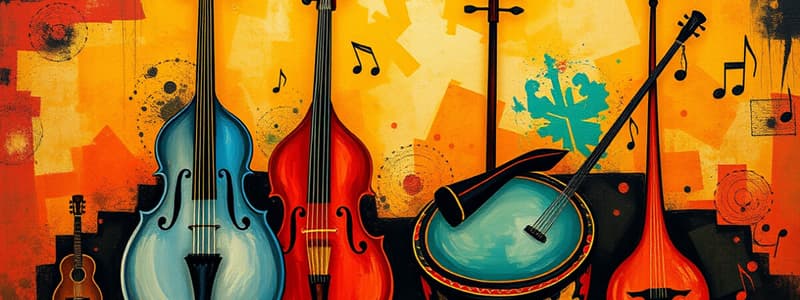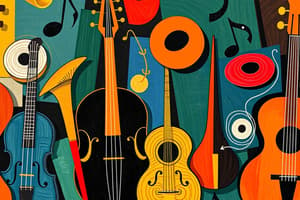Podcast
Questions and Answers
What are the four groups of musical instruments according to the NatyaShastra?
What are the four groups of musical instruments according to the NatyaShastra?
- Sushir Vadhya (correct)
- Tat Vadhya (correct)
- Avanadha Vadhya (correct)
- Ghan Vadhya (correct)
What are Tat Vadhya?
What are Tat Vadhya?
String Instruments
Name an example of a String Instrument.
Name an example of a String Instrument.
Tanpura
Which of the following is NOT a category of String Instruments?
Which of the following is NOT a category of String Instruments?
What does Sushir Vadhya refer to?
What does Sushir Vadhya refer to?
Which of these is a simple wind instrument?
Which of these is a simple wind instrument?
What does Avanadh mean?
What does Avanadh mean?
Which of the following is a category of percussion instruments?
Which of the following is a category of percussion instruments?
What are Ghan instruments made of?
What are Ghan instruments made of?
Which category includes instruments played with rotation or free movement?
Which category includes instruments played with rotation or free movement?
Flashcards are hidden until you start studying
Study Notes
Classification of Musical Instruments
- Musical instruments are categorized into four groups according to the NatyaShastra of Bharat Muni.
- Four groups:
- Tat Vadhya: String Instruments
- Sushir Vadhya: Wind Instruments
- Avanadha Vadhya: Percussion instruments made from animal skin
- Ghan Vadhya: Solid instruments or cymbals made from hard materials (metal, wood, etc.)
Tat Vadhya (String Instruments)
- Historically, strings were made from weeds, animal skins, or hair; metal strings marked a significant advancement.
- The frequency of notes is influenced by the string length and its distance from the instrument's bridge.
- Examples include:
- Tanpura
- Veena
- Sitar
- Sarod
- Sarangi
- Israj
- Dilruba
Categories of String Instruments
- Plucked Instruments: Examples include Tanpura and Swara-Mandal.
- Stroking Instruments: Such as Sitar and Sarod.
- Bowed Instruments: Examples include Sarangi, Israj, and Violin.
- Hammered Instruments: The Santoor is a notable example.
Sushir Vadhya (Wind Instruments)
- "Sushir" derives from the term for "hole," representing instruments with holes for air sound production.
- Constructed from bamboo, wood, or metal to house an air column.
Categories of Wind Instruments
- Simple Wind Instruments: Examples include Flute, Shankh, and Tutaari.
- Wind Instruments with Reeds: Such as Shehnai and Sudri.
Avanadh Vadhya (Percussion Instruments)
- The term "Avanadh" signifies to cover or conceal; these instruments feature a sound box covered with skin.
- The Bohemia Dundudhi is the most ancient known instrument in this category.
Categories of Percussion Instruments
- Finger-Played: Including Khanjira, Duff, and Dimdi.
- Stick-Played: Instruments like Dhol, Sambal, and Nagada.
- Palm-Played: Instruments such as Pakhawaj and Mridangam.
- String-Attached Instruments: The Damru falls within this category.
- Dual Playing: Instruments played with both palms and fingers include Tabla, Dholaki, and Dholak.
Ghan Vadhya (Solid Instruments)
- "Ghan" means solid; these instruments are solid in shape.
- Materials used include stone, bones, horns, wood, and metals.
Categories of Solid Instruments
- Palm and Finger Played: Examples are Chipli and Taal.
- Played with Sticks or Hammer: Includes Jal Trang, Kaastha Tarang, and Ghanta.
- Rotation or Free Movement: Instruments such as Ghunghru, Ghantika, Rattle, and Kabas.
Studying That Suits You
Use AI to generate personalized quizzes and flashcards to suit your learning preferences.




